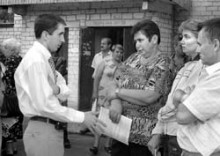Sustainable development has been discussed in Ukraine for at least twelve years. The debates began with the Planet Earth Summit in Rio de Janeiro, which adopted the concept of an economically, socially, and ecologically balanced development of the world community. The Ukrainian delegation to the summit signed this globally significant document and reaffirmed its commitment to its goals at the next summit five years later. Since then many studies and conferences have been devoted to sustainable development, its very notion, strategies, and tactics. The Ukrainian draft of the concept was finally developed in 2000, but was never approved in parliament to obtain the status of an action plan.
This is not surprising. Only 6% of all newborns in Ukraine are absolutely healthy. The average salary is a little over $100. There is no region in the country where air quality would meet public health standards, much like there are no water resources with absolutely clean water. Ukraine has the shortest life expectancy in all of Europe. According to experts, a third of all diseases in Ukraine are caused by bad environmental conditions. Meanwhile, all of the above indicators are used to determine the level of sustainable development, which means that Ukraine has to draft a document that would simultaneously address all these problems.
There have been many ideas, such as the so-called bio-plateau, a specially selected composition of water plants designed to purify water resources. Environmentalists prepared a study proving the economic feasibility of redistributing energy sources in favor of environmentally friendly sources of solar, wind, and water energy. Stringent measures to combat smoking and alcohol abuse were supposed to extend Ukrainians’ life expectancy.
The UN Office in Ukraine has developed and implemented a new project that envisions sustainable development at the local level, which international experts view as the most adequate form of development at the current stage. Seven potential partner municipalities were selected for this project. Residents of large neighborhoods in Zhytomyr, Rivne, Sumy, Kirovohrad, Odesa, Ivano-Frankivsk, and Chernivtsi were asked to identify their most urgent problems and think of ways to solve them. The staff of the UN project provided half of the necessary funds, with the remainder supplied by the local authorities. According to Ihor Stepanov, international monitoring expert of the Sustainable Municipal Development Project, four of the seven oblast centers refused to participate for various reasons. Meanwhile, municipalities in Zhytomyr, Rivne, and Ivano-Frankivsk launched the search for potential participants of the pilot project. They selected several local housing and utility management authorities known as ZhEKs and invited residents of buildings under their management to meet with the UN project staff, who selected the most active and enterprising residents.
As was to be expected, the initiative was met with a great deal of skepticism. As the project coincided with the presidential campaign, some residents viewed it as camouflaged campaigning for one of the presidential nominees, while others were surprised that they were required to take over the role of the local authorities in resolving municipal problems. Residents frequently used the UN project staff as a shoulder to cry on, demanding higher pensions, describing the plight of their ailing children, and complaining about rising prices. But it didn’t occur to anyone that they could handle many of the problems on their own.
Still, some enterprising souls were found. From the long list of priorities based on indicators of sustainable development all the project participants settled on social priorities. According to the project staff, virtually no one chose problems of clean air or building a civil society, as was the case in other countries. For example, the Zhytomyr community focused on the heating and hot water supply; Ivano-Frankivsk on outdoor sports facilities for children; and Rivne on window frames in schools.
Everyone grasped the significance of their contribution to a common cause. Neighborhoods chipped in to buy equipment and materials. Skilled workers volunteered to provide assistance for a fraction of what they are normally paid. The community became more involved as the project progressed. When they saw that they could handle the problem on their own, the residents worked with painstaking effort to get the job done as soon as possible.
As a result, they completed their projects in less than a month. Last year the UN program provided up to $50,000 for every city, with local municipalities covering the same amount. According to the project staff, the principles of sustainable development at the local level will soon be tested in other regions. For the time being this will be done mainly in oblast centers, since it is difficult to access many of Ukraine’s regions. The project staff is thinking of ways to spur municipalities toward more active efforts in solving their community’s problems, in particular by increasing the share of funding from municipalities from 50% to 60% of the project cost.
However, money is not the issue here. The project has proved that sustainable development begins in every individual building, street, and city. Ihor Stepanov believes that the social mobilization that they managed to achieve in the pilot buildings is not the end of it: “Uniting the public’s efforts in this way can resolve ecological, social, and even economic problems.”







